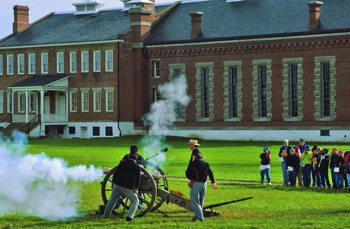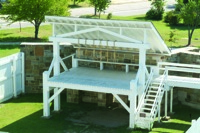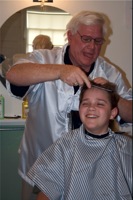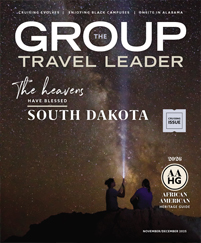
Photo courtesy Arkansas Tourism
You might think that a town would shy away from a rough past that included murderers and other assorted lawbreakers, the Trail of Tears, a notorious jail dubbed “Hell on the Border,” a judge known as the “hanging judge,” a gallows where more than 80 men were hanged, 66 saloons on the town’s main street and seven houses of ill repute.
But not Fort Smith, Ark., which embraces its colorful past and has made it one of its main tourist draws. After all, the visitor center is a historic former bordello whose owner, Miss Laura, personally greets motorcoach groups.
“So much of what we are relates to that [its history],” said Carolyn Joyce, tour and travel sales director for the Fort Smith Convention and Visitors Bureau and the modern-day incarnation of former madam Laura Zigler.
Located on the Arkansas River across from Oklahoma, Fort Smith began in 1817 as a frontier military post where soldiers tried to keep peace between the warring Osage and Cherokee tribes in what was then the Indian Territory.
A second fort was built in 1838 as the Trail of Tears, the forced removal of Indian tribes from their lands in the South and Southeast to Oklahoma, came through Fort Smith.
However, it was during the last three decades of the 19th century that Fort Smith’s rough reputation boomed.
“When they crossed the river here, they were in Indian Territory, without any law, so to speak. That lent itself to groups coming over here and getting into trouble,” said Joyce.
And that’s when federal Judge Isaac Parker earned his reputation.
“President Grant sent him here to clean up this area,” said Joyce. “Fort Smith National Historic Site houses Judge Parker’s courtroom, the old jail called Hell on the Border and the replica of the gallows where 79 men were hanged during Parker’s 21 years on the bench here.”
 |
| Courtesy Fort Smith CVB |
Most groups begin their visit at the visitors center, where an authentically decked out Joyce as Miss Laura greets them and gives a tour of the center, which includes some rooms restored to the early-20th-century look of when Zigler owned the business.
“We have a step-on guide and do a tour of the historic district; then, it’s on to the historic site,” she said.
The visitors center at the historic site, operated by the National Park Service, is in a large brick building originally built in 1851 as an Army barracks and later converted into the courthouse for the Federal Court for the Western District of Arkansas, over which Parker presided.
Parker’s courtroom was painstakingly restored 10 years ago as part of a $7.5 million renovation and restoration of the historic site.
“Accuracy was so important,” said Joyce. “They used a reporter’s descriptions — where the flag was hanging, where the clock was, those types of things.”
The site also includes the infamous jail in the basement, where up to 50 men were crowded into one large cell with limited ventilation and poor sanitary conditions, and a reconstruction of a new jail built in 1888.
As evening entertainment, groups can attend a re-enactment of the 1886 trial of Cherokee Bill in the courtroom.
“It was an actual trial held in the courtroom,” said Joyce. “Twelve members of the group sit on the jury. He was tried and hanged. He killed a guard in the second jail. When you are given a tour, you can see where all that occurred.”
A block away, the Fort Smith Museum of History “is another way of telling the Fort Smith story,” said Joyce.
Located in a century-old building that is on the National Register of Historic Places, the museum has two floors of artifacts relating to all aspects of the town’s history.
The museum, which is celebrating its 100th anniversary this year, is part of that history. It was originally started by a group of local women to save the former commissary, the oldest building at the national historic site, where it was located until 1979.
On the ground floor of the Fort Smith Museum of History is a replica 1920s pharmacy with a working soda fountain that is popular with groups for its ice cream floats, sodas and sundaes.
“You can catch the electric trolley there,” said Joyce. “It is a trolley that ran in downtown in the 1920s and has been restored. We put half of a group on the trolley, and half enjoy the museum and soda fountain; then they switch places.”
The trolley runs between the Fort Smith National Cemetery and the town’s main street, Garrison Avenue. During a ride, conductors give a colorful history of transportation in the city.
The Fort Smith Trolley Museum, a stop on the ride, has a collection of railroad passenger cars, engines and old Fort Smith buses.
On Saturdays during the winter, the Arkansas-Missouri Scenic Excursion Train leaves from the trolley museum for a four-hour roundtrip through the Boston Mountains to the small town of Winslow, Ark., during which it passes over 100-foot-tall trestles and through a 1,700-foot-long tunnel.
During other times of the year, the train, which features 1920s-era passenger cars, operates trips between Van Buren and Springdale, Ark.
Groups can also tour St. Scholastica Monastery, a National Register of Historic Places building built by Benedictine nuns in 1924 and added on to in 1928. “You get insight about life in a convent,” said Joyce. “Retired nuns live there, and they open the house up and let you go through on a tour. They have artwork done by nuns lining the walls that dates to the early 1900s."
“They have an indoor swimming pool that was built in 1928 and still works.”
Groups can relive the 1930s when the Park at West End reopens this spring after having been closed last year. The park features a Ferris wheel used at the 1935 San Diego World’s Fair, an Italian hand-painted carousel and a former Pullman railroad dining car that has been converted to a diner.
“Groups enjoy eating in the dining car,” said Joyce.
Give me the king’s cut
In 1958, people were all abuzz about the new Army recruit at Fort Chaffee near Fort Smith, Ark.
 |
| Courtesy Fort Smith CVB |
“At Fort Chaffee, they have the Barbershop Museum, which opened in 2008, that houses the shop where the guys coming into the Army got a buzz cut,” said Carolyn Joyce, tour and travel sales director for the Fort Smith Convention and Visitors Bureau. “It was where Elvis [Presley] was processed and got his famous buzz cut.”
The barbershop has been restored to its 1958 appearance when Presley got what was dubbed “the haircut heard ’round the world.” A blown-up photo of Elvis getting the haircut sits in a period barber’s chair.
The building also houses a museum with photos and artifacts about the 70-year history of Fort Chaffee and memorabilia from the movies Biloxi Blues, The Tuskegee Airmen and A Soldier’s Story that were filmed at the base.
Fort Chaffee is now closed, and 7,000 acres of the original 72,000 acres are being developed for commercial, residential and industrial use known as Chaffee Crossing.
The Barbershop Museum is part of the Chaffee Crossing Museum District, which also includes a doll museum with more than 6,000 dolls from around the world and a Vietnam Veterans Museum.









